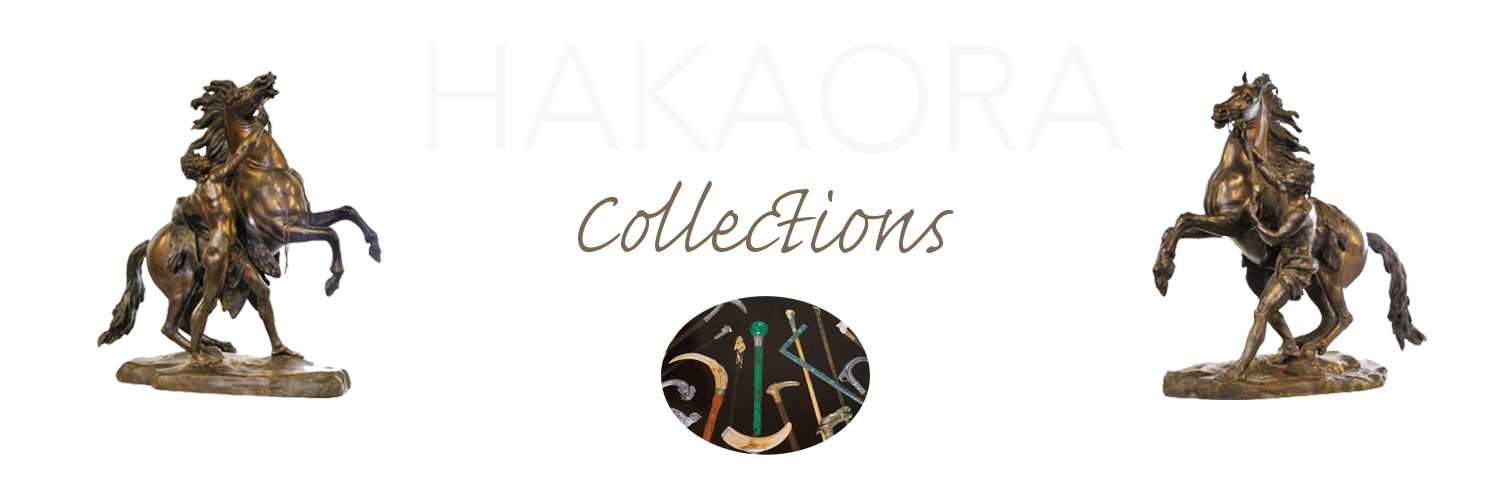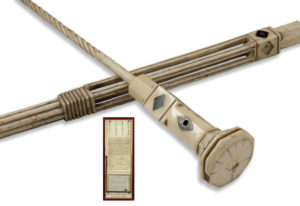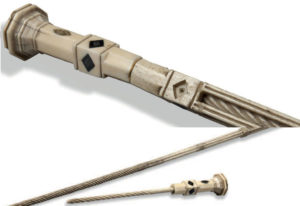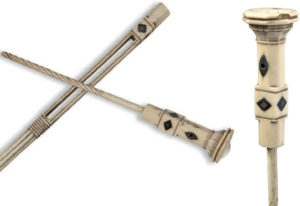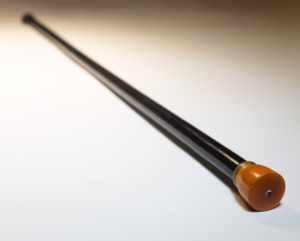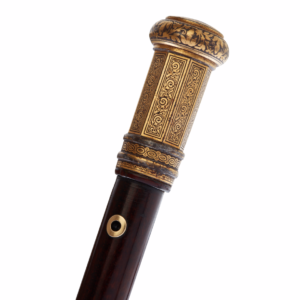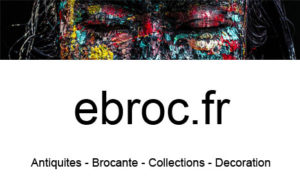La canne d’Honoré de Balzac – The cane of Honoré de Balzac
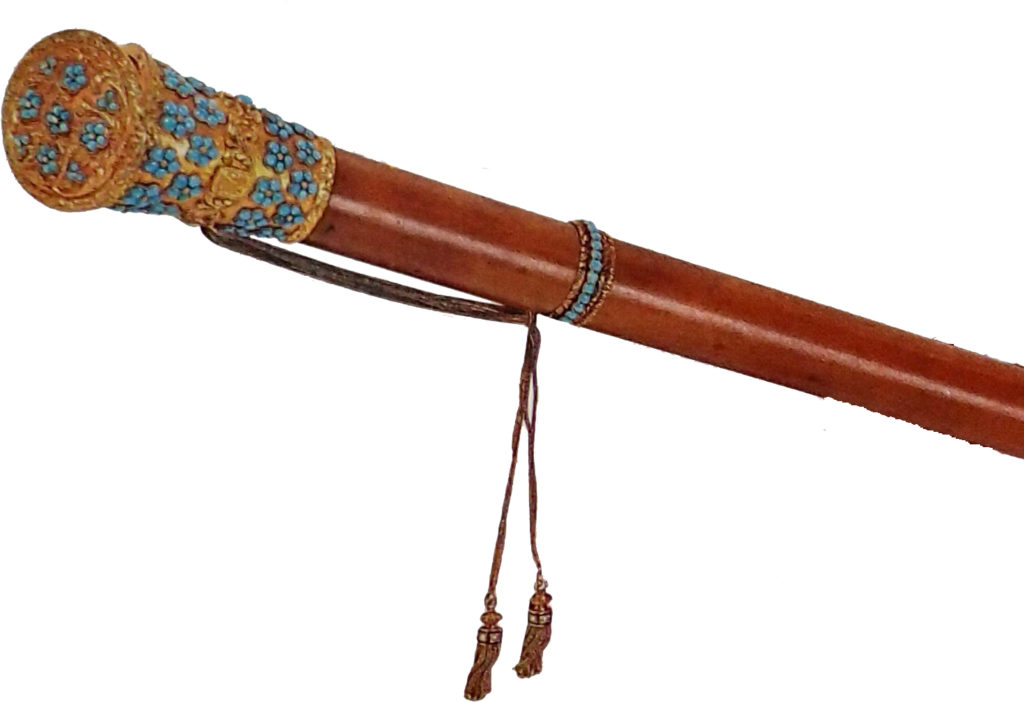
Année 1834, Honoré de Balzac vient de publier Eugénie Grandet. Ses livres se vendent comme des petits pains. Pourtant la critique est féroce. Un grand écrivain? Pour parfaire sa panoplie, Balzac se fait fabriquer une canne. Tous les Dandys en ont une. Mais l’homme de lettres, petit et gros, a bien conscience de ne pas être un arbitre des élégances. Alors sa canne sera énorme et son pommeau (on dit qu’il gardait à l’intérieur les cheveux de sa maitresse) sera serti de turquoises. Frissons dans le tout-Paris, on ne parle plus que de la « massue » de l’écrivain ! Il y fait même apposer un blason d’une famille Balzac issue de la noblesse – lui est fils de paysans. Peu importe les ricanements, Honoré de Balzac poursuivra son oeuvre, arborant tel un roi son sceptre, qu’il conservera toute sa vie.(source : ça m’intéresse – février – avril 2019)
Year 1834, Honoré de Balzac just published Eugénie Grandet. His books are flying off dealer lots. Yet criticism is fierce. A great writer? To improve its appearance, Balzac buy a cane specially made for him. All Dandies have one. But the man of letters, big and small, is well aware of not being an arbiter of elegance. Then his cane will be huge and his pommel (it is said that he kept inside the hair of his mistress) will be set with turquoises. Shivers in all Paris, we speak only of the « massive piece of wood » of the writer! He even places a coat of arms of a Balzac family from the nobility – he is the son of peasants. Regardless of the sneers, Honoré de Balzac will continue his work, wearing like a king his scepter, which he will keep his whole life. (source: ça m’intéresse – February – April 2019)
Source : vente Claude Aguttes (Paris le 28/5/19)
Lot n°65
Estimation : 100 000 – 120 000 €
CANNE DE NAPOLÉON À SAINTE-HÉLÈNE
Réalisée par un artisan anonyme chinois de Sainte-Hélène.
Canne en dent de narval, munie d’un pommeau plat sculpté à huit pans et d’un oeilleton de passage de dragonne. Manche à quatre faces incrustées de losanges de bois noirci. Dans le prolongement du manche, une baguette de 18,5 cm cannelée en spirale, imite un rostre de narval.
La pièce s’encastre dans le corps de la canne. Ce corps est ajouré en partie supérieure, laissant apparaître la baguette une fois rangée, puis se prolonge en forme de colonne cannelée, rudentée et torsadée à la pointe.
Longueur totale: 92 cm. Quelques petits manques.
Pièce unique et majeure de l’histoire
Napoléonienne.
Quelques accidents et manques (dont la férule). Restaurations au niveau de la baguette ainsi qu’en son milieu.
PROVENANCE Victor-Andrée Massena
Collection de la Famille Adler
Withehall Museum de Londres (fermé en 1962/1963)
Monsieur René Johnson
Monsieur Steff
Collection Lejeune
Monsieur A.
HISTORIQUE Ainsi que nous l’avons rappelé, une petite communauté chinoise, envoyée par la Compagnie des Indes, résidait sur l’île de Sainte-Hélène afin d’en assurer le bon fonctionnement. Parmi ces exilés, figuraient d’anciens cuisiniers, des paysans mais aussi des artisans.
Ces derniers réalisèrent plusieurs ouvrages pour Napoléon: certains sont modestes – comme la petite boîte à thé de l’Empereur et sa grande volière – d’autres, au contraire, constituent de véritables oeuvres d’art, à l’instar de la canne que nous présentons.
Cette canne à système en rostre de narval, ou licorne des mers, fonctionne au moyen d’une baguette escamotable, solidaire du pommeau.
La baguette avait pour but de pointer les cartes.
Elle constitue donc un symbole très fort, indissociable du grand homme et de son brillant parcours militaire. On imagine tout à fait l’Empereur, au moment de la rédaction du Mémorial de Sainte-Hélène, raconter au comte de Las Cases les mouvements de ses troupes, tout en pointant sur une carte les zones qu’il avait autrefois conquises ou pour lesquelles il avait eu des velléités.
Les chinois de Sainte-Hélène
En 1810, trois ans après l’abolition de la traite négrière dans l’Empire britannique, le colonel Patton, alors gouverneur de Sainte-Hélène, fit venir sur l’île une main-d’oeuvre chinoise destinée à remplacer la force de travail des esclaves.
Celle-ci, recrutée dans les comptoirs de la Compagnie des Indes orientales, se composait d’agriculteurs, d’éleveurs, de menuisiers, de maçons et de tailleurs de pierre. Extrêmement «laborieuse et industrieuse», selon les mots du colonel, elle regroupa bientôt plusieurs centaines d’employés contractuels, qui percevaient un modeste salaire annuel de 28 livres sterling[1].
Quelques-uns de ces travailleurs immigrés entrèrent au service de Napoléon.
Les écrits de Louis-Joseph Marchand et du mamelouk Ali, fidèles domestiques de l’Empereur, livrent de précieuses informations sur la nature de leurs activités quotidiennes à Longwood. Les chinois furent affectés à de multiples tâches, occupant tour à tour les postes de jardiniers, menuisiers, voire cuisiniers. De nombreux cuisiniers, tous fort médiocres, se succédèrent aux fourneaux de Longwood. Aussi n’était-il pas rare qu’à la suite d’un renvoi du maître-queue ou de sa démission subite, les domestiques chinois prissent le relais durant quelques mois, servant à la table de l’Empereur des plats traditionnels de leur pays – que ce dernier, paraît-il, n’appréciait pas toujours!
À l’exception de ces interludes culinaires, les chinois oeuvrèrent essentiellement aux aménagements extérieurs de la résidence de l’Empereur. On sait ainsi qu’ils participèrent activement aux grands travaux paysagers qu’initia Napoléon en 1819, pour se distraire de ses geôliers. Les nouveaux jardins achevés, deux domestiques chinois en prirent soin quotidiennement, recevant, en plus de leurs collations, 30 shillings par mois de la part de l’Empereur. À la demande de ce dernier, ils y installèrent une grande volière[2] de bambous, couronnée d’une aigle et décorée de motifs traditionnels chinois. Sur les parois d’une petite grotte artificielle qu’on avait ménagée dans une partie basse du jardin, ils sculptèrent également de belles boiseries à motifs de dragons et d’oiseaux[3].
Dans ses Mémoires, Marchand souligne le talent de ces artisans. Parlant de l’un d’eux, il écrit: «Parmi les Chinois, il y en avait un dans l’île qui sculptait avec goût et était menuisier de son état. L’Empereur témoigna le désir que M. de Montholon lui fit faire un kiosque chinois dans un endroit du jardin qu’il désigna lui-même […], pour pouvoir de là découvrir la mer et se retirer de temps en temps[4]». Sans doute est-ce à ce même sculpteur de qualité que Napoléon commanda sa fameuse canne en rostre de narval? Cette dernière constitue, en tous les cas, un témoignage rare et précieux du travail des artisans chinois à Sainte-Hélène. Reconnaissant de leurs services, l’Empereur n’oublia d’ailleurs pas de les faire figurer dans son testament, à la suite de ses proches et fidèles.
[1]Ces informations sont tirées du livre de Michel Dancoisne-Martineau, Chroniques de Sainte-Hélène: Atlantique sud, Paris, Perrin, 2011, chapitre 41.
[2]De nos jours, cette volière est conservée au musée-hôtel Bertrand de Châteauroux, où elle a été remontée.
[3] Gilbert Martineau, La vie quotidienne à Sainte-Hélène au temps de Napoléon, Paris, Tallandier, 2005.
[4] Louis-Joseph Marchand, Mémoires de Marchand, premier valet de chambre et exécuteur testamentaire de l’Empereur à Sainte-Hélène, Paris, Tallandier, 1991, p. 266.
Source : HENRY ALDRIDGE & SON LIMITED
(Devizes le 19/10/19)
Lot n°263
Estimation : 80 000 – 120 000 £
Adjugée le 19/10/19 pour la somme de 85 000 £ soit 105 400 £ charges incluses.
R.M.S. TITANIC: One of the most important three dimensional Titanic artifacts ever offered for auction, survivor Ella White’s historic walking cane.
« We only had 22 in our boat… Then we turned and went back, and lingered around there for a long time, trying to locate the other boats, but we could not locate them except by hearing them. The only way they could locate us was by my electric lamp. The lamp on the boat was absolutely worth nothing. They tinkered with it all along, but they could not get it in shape. I had an electric cane – a cane with an electric light in it – and that was the only light we had. We sat there for a long time, and we saw the ship go down, distinctly. »
These were the words of Mrs. J. Stuart (Ella) White on Day 12 of the U.S. Senate Inquiry into the Titanic disaster in response to a question from Senator Alden Smith.
A Titanic survivor, Mrs. White made her way during the chaos of the night into a lifeboat, carrying her black enamelled walking stick complete with an amber coloured Bakelite, battery-illuminated crown. Walter Lord, in his seminal book « A Night to Remember », wrote that while Mrs. White did not help row No. 8, she nevertheless appointed herself a sort of signalman. She had a cane with a built in electric light, and during most of the night she waved it fiercely about, « alternatively helping and confusing everyone. »
She was born on December 18th, 1856. A New Yorker, she had been travelling through Europe and was headed back to New York by way of the Titanic’s maiden voyage. During her travels, she injured her foot causing her to use a cane to support her balance. At the American Inquiry, Senator Smith asked her if she experienced any problem in getting into the lifeboat. She replied, in part:
…They handled me very carefully, because I could hardly step. They lifted me in very carefully and very nicely… As I said, my condition was such that I had to be handled rather carefully…
White boarded the ship in Cherbourg with her maid and man servant and her travelling companion, Marie Young, with whom she stayed in First-Class cabin C-32 where she remained for most of the voyage. She and Young had acquired live poultry to bring back to New York. Referring to the impact with the iceberg, White stated, « there did not seem to me that there was any very great impact at all. It was just as though we went over about a thousand marbles. There was nothing terrifying about it at all. » When she came on deck she found other passengers casually standing about. It wasn’t until she heard the order to put on life preservers that she comprehended the magnitude of the situation.
White boarded lifeboat 8 along with her maid and Miss Young. Other occupants of the lifeboat included Ellen Bird, maid to Ida Straus, the Countess of Rothes and Mary Alice Holverson, the wife of Titanic victim Alexander Oskar Holverson.
In 2017, Henry Aldridge & Son auctioned an unposted letter written by Mr. Holverson to his mother on Titanic stationery which had been retrieved from his body. It sold for a world record sum. It is fitting that we now offer the electric cane that was in the lifeboat with his wife.
According to White, her electric cane saved the day by filling in for the defective lifeboat lamps which were « absolutely worth nothing. » However, not everyone that night agreed with White’s characterization of her cane’s usefulness. In his book, « Titanic and Other Ships », senior surviving officer Charles Lightoller had this to say about it: « …more than could be said of one very good lady who achieved fame by waiving an electric light and successfully blinding us as we worked on the boats. It puzzled me until I found she had it installed in the head of her walking stick. I am afraid she was rather disappointed on finding out that her precious light was not a bit appreciated. Arriving in safety on board the Carpathia, she tried to make out that someone had stolen her wretched stick, whereas it had been merely taken from her, in response to my request that someone would throw the damn thing overboard. »
Thus, it was not in the lifeboat alone that White wielded her electric light, but on the deck of Titanic as well, « successfully blinding » the crewmen as they were attempting to lower the boats! So annoying was her cane that Lightoller had it taken from her when she arrived on Carpathia. White’s self-serving testimony about the benefits of her cane may have been presumptuous at best. According to Lightoller it didn’t help the crew, it blinded them. It was apparently fortunate for the crew working the boats that lifeboat 8 was the second to be lowered on the port side. Another claim to fame for lifeboat 8 is that it was the boat Isidor and Ida Straus had been invited to enter along with Ida’s maid. No doubt close by, the Strauses may have likewise been blinded by White’s cane.
This lot is a sight to behold. The black enamelled walking stick with rubber base is visually contrasted by its amber coloured bakelite, battery-illuminated crown containing a clear bulb. The cane is approximately 35½ins. long with a diameter of about 1¼ins. » It is in beautiful condition, obviously owing to its relatively short but historically significant use until White was well enough to walk without it.
Oddly enough, for all that White had hoped to achieve with her electric cane, lifeboat 8 had ventured the farthest from the scene, in the opposite direction of Carpathia, and eventually had to make its way back from whence it came.
Henry Aldridge and Son is honoured to be able to offer this historic cane which had been in White’s family for the past 107 years. Its historic significance coupled with its visual allure is unrivalled. One of only a handful of three dimensional items to have survived that was used on Titanic, a lifeboat, the Carpathia and on the dock in New York. It is recounted in various places including the U.S. Inquiry at which the Chairman of the special subcommittee, himself, inquired about it, in Walter Lord’s book « A Night to Remember », Charles Lightoller’s seminal autobiography « Titanic and Other Ships » and more recently in Michael Davie’s book « Titanic – The Death and Life of a Legend ».
Whether the cane saved the day as White believed or caused confusion as Lightoller wrote in his book, we are unaware of any other passenger artefact that directly played a role in the events of that night in such a way. An unparalleled artefact with exceptional provenance worthy of a fine museum collection.
The lot is accompanied by a copy of United States District Court Hearing « Claim of Ella Holmes White, » excerpts from a copy of Michael Davie’s book referenced above and the original notarized affidavit from Ella White’s family outlining the history of the cane.
Provenance: The family of Ella White; Titanic Museum Attraction, the world’s largest Titanic museum in Pigeon Forge (see photo below) where the cane was on display until 4th October 2019.
THE PRINCE CHARLES EDWARD STUART WALKING CANE,18TH CENTURY
Lyon & Turnbull Auction : 12/08/20
Estimation : 10 000 – 20 000 £
Hammer Price : 14.000 £
unmarked, the gold inlaid steel head with compressed gold inlaid pommel, with British crown surmounting initials ‘CE’ within arched and foliate borders, the lower panelled section of the head formed of finely inlaid foliate scrolls with inlaid ribbed and plain collars below, the tapered snake wood stick with inlaid gold eyelet and later brass ferule to point
(Steel head 6.5cm long, pommel 3.3cm diameter, overall length 94.5cm)
Provenance:
By repute Prince Charles Edward Stuart
and then gifted to a French Noble Family
By descent till circa 1905 – 1909
Presented to Alfred William Cox (1857 – 1919)
By direct descent
Exhibited: Stuart and Cromwell Relics, and articles of interest connected with the Stuart Period , Cambridge Antiquarian Society, Guildhall Cambridge 15th-20th May 1911, item 5 (lent anonymously) Note: Although many relics of the Jacobite Cause exist, few are directly and personally connected with the Stuart family, or a single member, so directly. This walking cane was no doubt an important and highly personal accessory of the fashionable Prince Charles Edward Stuart, used within the Courts of Europe when petitioning his cause. A history of portraiture illustrates the Prince as a young, fashionable, educated and confident man. With much of his life spent in Europe in the presence of many Royal courts, he was keen to portray an image of the upmost grandeur at all times. In the 18th century, it was de rigueur to own a fine walking cane; a reflection of one’s societal status, wealth and artistic interests. Sadly, no portraits can be found of the Prince which feature a walking cane, as these more often focus on official symbols of office and heraldry. However, in the Scottish National Portrait Gallery’s collection, Paolo Monaldi & Pubalacci & Silvestri’s exceptional painting, Prince James receiving his son, Prince Henry, in front of the Palazzo del Re , Prince Charles’ father James and his court can be seen with several walking canes, serving as a statement accessory; a clear indication of the fashionable taste amongst the Stuart’s social circles.
It is remarkable to consider the cane’s long history with such few breaks in ownership. When it was exhibited in 1911, it was recorded as having been ‘used by Prince Charles when he was at the French court, and was presented by him to a French nobleman, in whose family it has remained until a few years ago, when it was presented by the present holder of the title to the lender’.
For some time, the cane was considered to have been a gift to Prince Charles from King Louis, however it has not been possible to substantiate this. Despite this, the worked elements of the cane are certainly European, and draw comparisons to some of the finest gold inlaid and steel metalwork made in France and Germany. A closer look at the inlaid decoration is revealing: the placement of the British crown above his initials rather boldly indicates his rightful claim to the throne. Being the monarch’s crown, it is possible that this cane was made for Charles after his father’s death and he titled himself King Charles III. Indeed, other personal monogrammed items which survive feature the initials CP for Carlos Princepus . While there is some speculation as to whether the cane was gifted by King Louis, there is no doubt surrounding the quality of manufacture. Moreover, the gifting to a French noble family by Prince Charles successfully traces the provenance back to Charles’ own lifetime; a highly unusual feat and few comparisons exist outwith established museum collections. By the 1911 exhibition the cane was the property (although lent anonymously) of Alfred William Cox. Alfred was a remarkable character of Victorian society. Son of Alexander Robb Cox (1826-1880) he came from a long line of successful Scottish jute merchants and factory owners working in Dundee and Liverpool. In 1879, and on failing his entrance exams for the Military Academy at Woolwich, he was given £100 and an allowance to travel to Australia. His father’s intention was for him to learn about the sheep trade and presumably set up his own. But before long he had fallen into his favourite leisure pursuit and was again involved in gambling on horse racing, which had perhaps originally led to his failed exams back in England. On hearing this, his father threatened to cut his allowance and seek his return. For a short time at least, Alfred went into sheep farming. This was not to last long however, his interests inevitably shifted over a game of cards in which he won a share in what became the Broken Hill silver mine, for a sum £120. He would return to England a wealthy man in the late 1880’s with his shares value then estimated at £1,260,000 (some £70m in today’s terms). On his return he became one of Britain’s most successful race horse owners and had many renowned winners, perhaps most famous is Bayardo, a short career which is still remembered today. Late Victorian and Edwardian horse racing at the highest levels was a highly a social event. A fashionable cane such as this would have served Alfred well when in attendance at the Royal Enclosure, and especially when in the company of the Prince of Wales (later King Edward VII) who frequented there. Alfred Cox had a small but fine collection of canes, this no doubt the highlight. How it came into his collection when it was ‘presented’ to him by the Noble French family remains a mystery, but family tradition has often held that it may have been in lieu of a debt for a horse, stud fees, or likely gambling.
